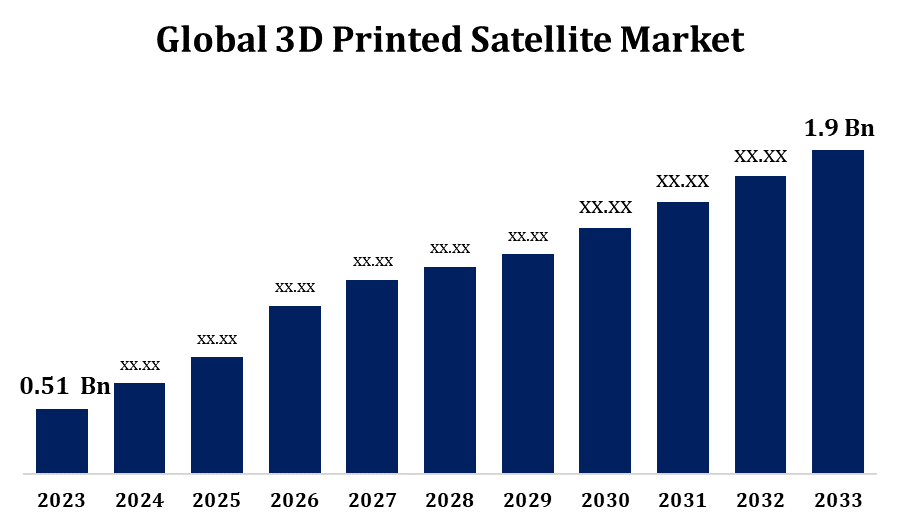Global 3D Printed Satellite Market Size To Worth USD 1.9 billion By 2033 | CAGR of 14.06%
Category: Aerospace & DefenseGlobal 3D Printed Satellite Market Size To Worth USD 1.9 billion By 2033
According to a research report published by Spherical Insights & Consulting, the Global 3D Printed Satellite Market Size to grow from USD 0.51 billion in 2023 to USD 1.9 billion by 2033, at a Compound Annual Growth Rate (CAGR) of 14.06% during the forecast period.

Get more details on this report -
Browse key industry insights spread across 220 pages with 106 Market data tables and figures & charts from the report on the Global 3D Printed Satellite Market Size, Share, and COVID-19 Impact Analysis, By Satellite Platform (Nanosatellites, Microsatellites, Minisatellites, Mid-Size Satellites, Geostationary Satellites), By Application (Communication, Earth Observation, Navigation, Scientific Research, Military Surveillance), By End User (Government Agencies, Commercial Enterprises, Research Institutions, Military), and By Region (North America, Europe, Asia-Pacific, Latin America, Middle East, and Africa), Analysis and Forecast 2023 - 2033. " Get Detailed Report Description Here: https://www.sphericalinsights.com/reports/3d-printed-satellite-market
The 3D printed satellite market is experiencing robust growth, fueled by advancements in additive manufacturing technology and the increasing demand for compact, cost-effective space solutions. 3D printing enables the creation of intricate satellite components that are lighter, quicker to produce, and more affordable compared to conventional methods. This has paved the way for more efficient and tailored designs, especially in the development of small satellites. The market is also being propelled by the growing demand for satellite services, such as communications, Earth observation, and navigation. Leading companies are leveraging 3D printing to manufacture components like antennas, propulsion systems, and structural elements, enhancing satellite performance. With the expanding space industry and the rise of satellite constellations, market growth is expected to accelerate in the coming years.
3D Printed Satellite Market Value Chain Analysis
The value chain of the 3D printed satellite market spans several key stages, starting with research and development (R&D) focused on advancing additive manufacturing technologies. Leading players, including satellite manufacturers and aerospace companies, invest in innovation to develop new 3D printing materials and processes. The next phase involves designing satellite components, with 3D printing enabling customized, lightweight designs that boost performance. These parts are then produced using specialized 3D printers capable of working with aerospace-grade materials. Following production, assembly and integration take place, where the printed components are incorporated into the satellite systems. Testing and quality assurance ensure the satellites meet rigorous performance standards. Finally, the market reaches end-users such as space agencies, private companies, and commercial entities deploying satellites for various purposes like communications, Earth observation, and navigation.
3D Printed Satellite Market Opportunity Analysis
The 3D printed satellite market offers substantial opportunities, particularly with the growing demand for small satellites and satellite constellations. As space missions become more budget-conscious, 3D printing provides cost-effective and fast manufacturing solutions, allowing more organizations to deploy satellites. The ability to produce lightweight and customizable components improves satellite performance while lowering launch costs. Additionally, the rising need for Earth observation, telecommunications, and remote sensing satellites is further fueling market growth. Advancements in materials, such as high-performance polymers and metals, open up new possibilities for creating durable and efficient satellite parts. Furthermore, the increasing emphasis on space exploration, including Mars missions and deep space research, creates opportunities for 3D printed satellites to play a critical role in the development of next-generation spacecraft and satellite technologies.
The increasing demand for small satellites is a major driver of growth in the 3D printed satellite market. As space missions become more affordable and accessible, small satellites are being deployed for a range of applications, such as Earth observation, communications, and remote sensing. 3D printing provides an efficient way to produce lightweight, customizable components that are perfectly suited for these compact satellites. With lower production costs, quicker lead times, and the ability to create complex designs, 3D printing helps manufacturers meet the specific needs of small satellite projects. As the space industry continues to focus on miniaturization and cost-efficiency, the demand for 3D printed satellite parts is set to rise, driving market expansion. This growth is further bolstered by advancements in materials and printing technologies.
A major challenge in the 3D printed satellite market is the limited availability of high-performance materials that meet the stringent requirements for space applications. Although progress has been made, the current selection of 3D printing materials may not fully satisfy the demands of space environments, such as resistance to radiation, extreme temperatures, and mechanical stress. Another issue is the complexity of quality control and certification for 3D printed components, as ensuring reliability and safety in space missions is paramount. Furthermore, the high cost of advanced 3D printing equipment and the specialized expertise required to operate these machines can be a barrier for some organizations. Finally, integrating 3D printing with traditional satellite manufacturing methods poses a challenge, necessitating significant changes in design and production workflows.
Insights by Satellite Platform
The Microsatellites segment accounted for the largest market share over the forecast period 2023 to 2033. Microsatellites, which typically weigh between 10 and 100 kilograms, are ideal candidates for 3D printing due to the technology's ability to create complex, customized components tailored to specific mission needs. 3D printing helps reduce production time and costs, enabling the development of microsatellites for various applications, including Earth observation, telecommunications, and scientific research. As space agencies and private companies continue to deploy small satellite constellations, the demand for microsatellites is expected to grow. Additionally, 3D printing offers greater design flexibility, improving satellite performance and minimizing material waste. This shift towards cost-efficiency and miniaturization positions the microsatellite segment as a crucial driver of growth in the 3D printed satellite market.
Insights by Application
The communication segment accounted for the largest market share over the forecast period 2023 to 2033. 3D printing allows for the creation of lightweight, cost-effective, and highly customizable components for communication satellites. These satellites are crucial for providing global coverage, especially in remote and underserved regions, for services like broadband, mobile, and internet. Through 3D printing, manufacturers can produce complex parts, including antennas, payloads, and structural components, with shorter lead times and reduced production costs. This improves the efficiency of satellite deployment for communication purposes. As the demand for high-speed connectivity grows, particularly for IoT, 5G networks, and rural areas, the need for communication satellites is expected to rise, further accelerating the adoption of 3D printing technologies in satellite manufacturing.
Insights by End User
The government agencies segment accounted for the largest market share over the forecast period 2023 to 2033. Government space agencies, including NASA, the European Space Agency (ESA), and the Indian Space Research Organisation (ISRO), are leading the way in adopting 3D printing for satellite development. The ability to produce lightweight, cost-effective, and customized components is particularly attractive for government-funded space missions, which often face strict budgets and tight schedules. 3D printing also facilitates the creation of specialized satellites for research, Earth observation, and national security purposes. As government agencies continue to pursue innovative approaches to space exploration and satellite constellations, the demand for 3D printing technologies is expected to increase, further driving growth in this segment of the market.
Insights by Region

Get more details on this report -
North America is anticipated to dominate the 3D Printed Satellite Market from 2023 to 2033. The U.S. and Canada are leaders in space innovation, with numerous companies exploring additive manufacturing technologies to reduce satellite production costs and enhance performance. The demand for small satellites, driven by commercial applications in communications, Earth observation, and remote sensing, is particularly strong in North America. Government agencies like NASA and private companies such as SpaceX are at the forefront of adopting 3D printing for satellite components. Additionally, advancements in materials, including high-performance polymers and metals, further support the market. The region's established infrastructure for space exploration and its growing focus on satellite constellations are expected to continue driving the adoption of 3D printing in satellite manufacturing.
Asia Pacific is witnessing the fastest market growth between 2023 to 2033. China, India, Japan, and South Korea are at the forefront of aerospace technology advancements, driven by the growing demand for satellite-based services such as telecommunications, Earth observation, and navigation. The use of 3D printing in satellite manufacturing provides cost-effective solutions, especially for small and medium-sized satellite projects. As space programs expand, particularly in India and China, the need for more innovative and efficient production methods becomes increasingly important. Additionally, Asia-Pacific’s emphasis on advancing space exploration and satellite constellations presents opportunities for 3D printed components to play a key role. With the region’s expanding space industry and technological progress, market growth is expected to accelerate.
Recent Market Developments
- In March 2024, Boeing has secured a USD 439.6 million contract to produce the 12th Wideband Global SATCOM (WGS) communications satellite for the U.S. Space Force's Space Systems Command.
Major players in the market
- Concept Laser
- 3D Systems
- Stratasys
- ExOne
- Farsoon Technologies
- Rico
- Prodways
- DDM Systems
- Voxeljet
- Arcam
- EOS Group
- Renishaw
- SLM Solutions
Market Segmentation
This study forecasts revenue at global, regional, and country levels from 2023 to 2033.
3D Printed Satellite Market, Satellite Platform Analysis
- Nanosatellites
- Microsatellites
- Minisatellites
- Mid-Size Satellites
- Geostationary Satellites
3D Printed Satellite Market, Application Analysis
- Communication
- Earth Observation
- Navigation
- Scientific Research
- Military Surveillance
3D Printed Satellite Market, End User Analysis
- Government Agencies
- Commercial Enterprises
- Research Institutions
- Military
3D Printed Satellite Market, Regional Analysis
- North America
- US
- Canada
- Mexico
- Europe
- Germany
- Uk
- France
- Italy
- Spain
- Russia
- Rest of Europe
- Asia Pacific
- China
- Japan
- India
- South Korea
- Australia
- Rest of Asia Pacific
- South America
- Brazil
- Argentina
- Rest of South America
- Middle East & Africa
- UAE
- Saudi Arabia
- Qatar
- South Africa
- Rest of the Middle East & Africa
About the Spherical Insights & Consulting
Spherical Insights & Consulting is a market research and consulting firm which provides actionable market research study, quantitative forecasting and trends analysis provides forward-looking insight especially designed for decision makers and aids ROI.
Which is catering to different industry such as financial sectors, industrial sectors, government organizations, universities, non-profits and corporations. The company's mission is to work with businesses to achieve business objectives and maintain strategic improvements.
CONTACT US:
For More Information on Your Target Market, Please Contact Us Below:
Phone: +1 303 800 4326 (the U.S.)
Phone: +91 90289 24100 (APAC)
Email: inquiry@sphericalinsights.com, sales@sphericalinsights.com
Contact Us: https://www.sphericalinsights.com/contact-us
Need help to buy this report?